African Painted Dog Safari and Cape Town Exploration Extension
African Painted Dog Safari + Cape Town Exploration
14-Day Adventure
August 15 - 23, 2025
Safari with Endangered Painted Dogs
August 15 - 25, 2025 / 11 Days - 10 Nights
$6292 pp / double occupancy
$850.00 Single Supplement
This safari is an exclusive opportunity to spot the endangered African Painted Dog (plus the full range of African wildlife) in its natural habitat. We will visit with a conservationist who will tell us more about the efforts to protect this incredible species.
Professional naturalist guide, Destination: WIldlife leader
Comfortable vehicle and all lodging and meals included.
Cape Town Extension:
4 Days 3 Nights / August 25-28
Add African Penguins to your safari list, and complete your adventure by discovering one of South Africa’s famous vineyards
$2058.00pp / double occupancy
250.00 single supplement
5% of the cost of your safari is donated in your name to a non-profit conservation organization supporting Painted Dogs or other canids.
The Experience
★ Introducing African Painted Dogs! Kruger NP is one of the last strongholds of this little-known, rare, and fascinating (IUNC) Endangered species.
★ Get Personal For your naturalist guide, painted dogs are personal, [ African painted dog is ] my favorite mammal in the African bush,” Marc Cronje has been personally involved in conservation efforts for decades.
★ Go Wild Kruger National Park’s three biomes - forest grassland and savanna - each support unique birds and wildlife, including the world’s largest leopard population, plus rhino, giraffe, elephants, lions, water buffalo, and more.
★ Go City - South African Style After our time in the wild, head to Cape Town to discover why South Africa’s wines are taking the world by storm, explore Table Mountain, and meet some African penguins.
★ Make a Difference on Two Continents: This itinerary directly supports wildlife and habitat conservation and community well-being programs at Kruger National Park and Idube Game Reserve and in the US. Destination: Wildlife will donate 5% of your trip cost in your name to your choice of one of these conservation organizations doing vital work for species and or habitat conservation:
The Wolf Conservation Center, The Grassland Bird Trust, or The Great Swamp Conservancy
The Highlights
Introducing
African Painted Dogs!
For wildlife enthusiasts “in the know,” seeing the legendary “painted wolf” in action is a top bucket list experience.
Get to Know the Family: These long-legged canines’ Latin name (Lycaon pictus) means “painted wolf,” referring to the animal's irregular, mottled coat, which features beautiful and unique patches of red, black, brown, white, and yellow fur. They live in highly structured packs (usually between 6 and 20 members strong) that are usually dominated by a monogamous breeding pair. These dogs are very social, and packs have been known to share food and assist weak or ill members. Interactions between members of a pack are common, and the dogs communicate by touch, actions, and vocalizations.
But Don’t Get Comfortable: African Wild Dogs hunt in formidable, cooperative packs with a high-stamina approach, sometimes chasing prey over great distances at speeds of up to 40 miles (64 kilometers) per hour! Their diet mainly consists of medium-sized ungulates such as impalas, gazelles and wildebeests. They have an impressive hunting success rate of around 80%, one of the highest among predators.
The Threat is Real: African Painted Dogs once roamed across the African continent. Today, they are threatened by shrinking habitats and misunderstandings and are unfortunately also quite susceptible to diseases spread by domestic animals. Only an estimated 6,000 of these remarkable animals are left in the wild!
One of the best places on Earth to see these fascinating creatures is undoubtedly the Kruger National Park in South Africa. Everything that can be said about “Kruger” (as it is affectionately known) has probably already been said, but suffice to say that it is undoubtedly one of the greatest wildlife reserves on the planet.
And, of course, we will enjoy comfortable Kruger National Park lodges, a private vehicle, and a professional naturalist guide (in this case, Marc Cronje, one of my favorite people in the world,) plus the excellent company of a few wolf/dog and wildlife lovers.
About Kruger National Park
The peacefulness of Kruger may lull you into a relaxed state - but don’t be fooled! Kruger National Park is WILD! Image: ©Marc Cronje
Kruger National Park covers a vast area of 19,485 square kilometers (7,523 square miles) in the northeastern portion of the country and extends 360 kilometers (220 mi) from north to south and 65 kilometers (40 mi) from east to west. The South African government protected the park’s first areas in 1898, in 1926 it officially became South Africa’s first national park. Kruger NP is now part of the Great Limpopo Transfrontier Park, a huge peace park that links Kruger National Park with the Gonarezhou National Park in Zimbabwe and the Limpopo National Park in Mozambique.
Giraffe in Kruger national Park. Image ©Marc Cronje
The park welcomes more than 1.5 million visitors every year yet never feels crowded. All the famous “Big Five” game animals (Buffalo, Elephant, Rhinoceros, Lion and Leopard) are found in Kruger National Park, which has more species (147) of large mammals than any other African game reserve. Over 520 species of birds have also been documented here, along with vast numbers of reptiles, insects, and other fauna and flora.
Our safari will cover the most important areas of the Southern section of Kruger. It is the most visited part of the game reserve, and with good reason: it is the area where it is the easiest to see all of the Big Five animals and many others, including the very rare and Endangered African Wild Dog.
We will also visit the famous Sabi Sands Game Reserve, a 65,000-hectare reserve pioneered by local landowners in the 1950s. It shares an unfenced border just to the west of the Kruger National Park.
Wildlife species in the Sabi Sands Reserve is well habituated, resulting in extraordinary intimate encounters and prolific sightings, particularly of the elusive Leopard and the remarkable African Wild Dog. Bring your camera! Excellent photographs of many iconic species are almost guaranteed in Sabi Sands!
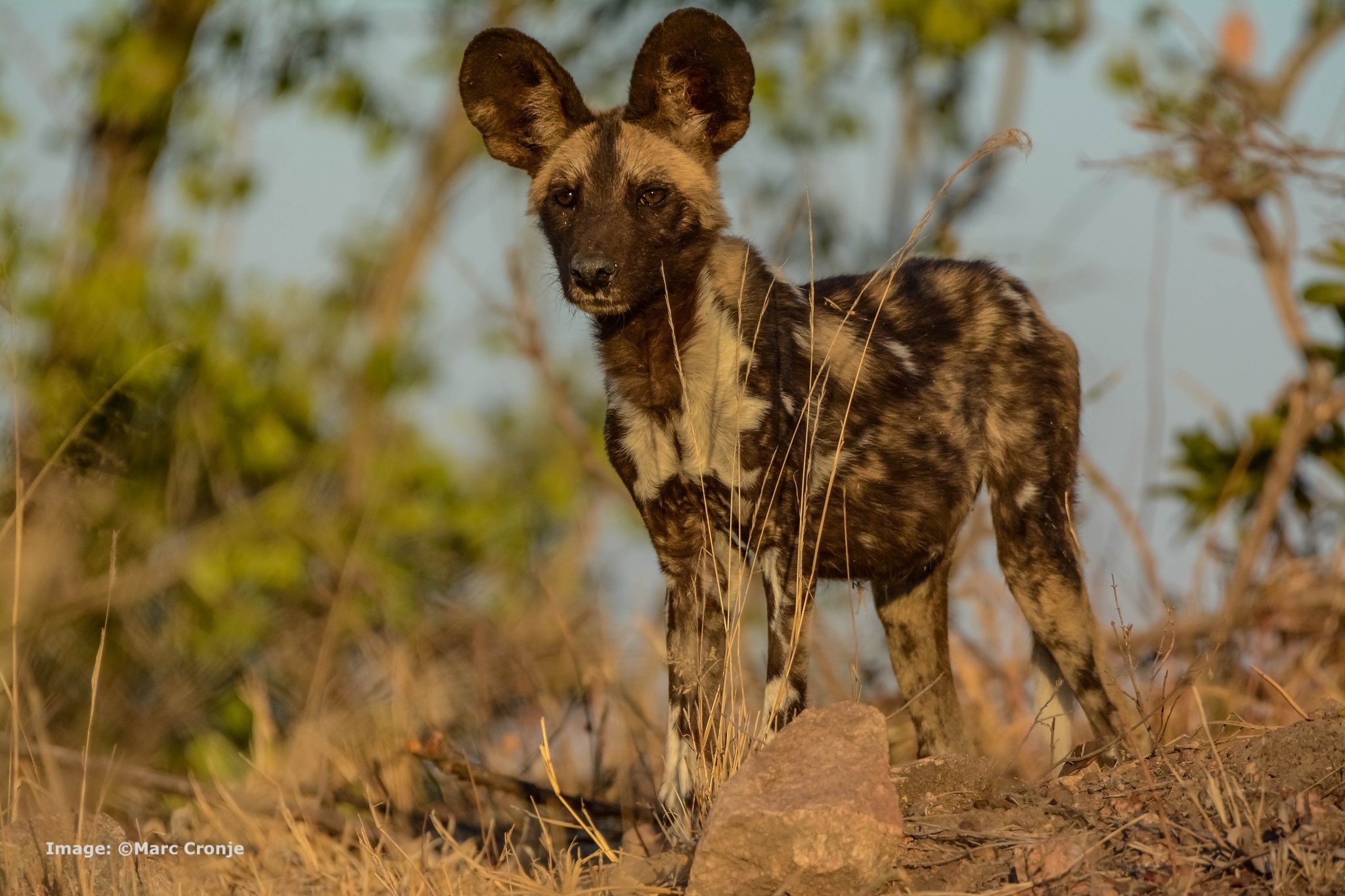
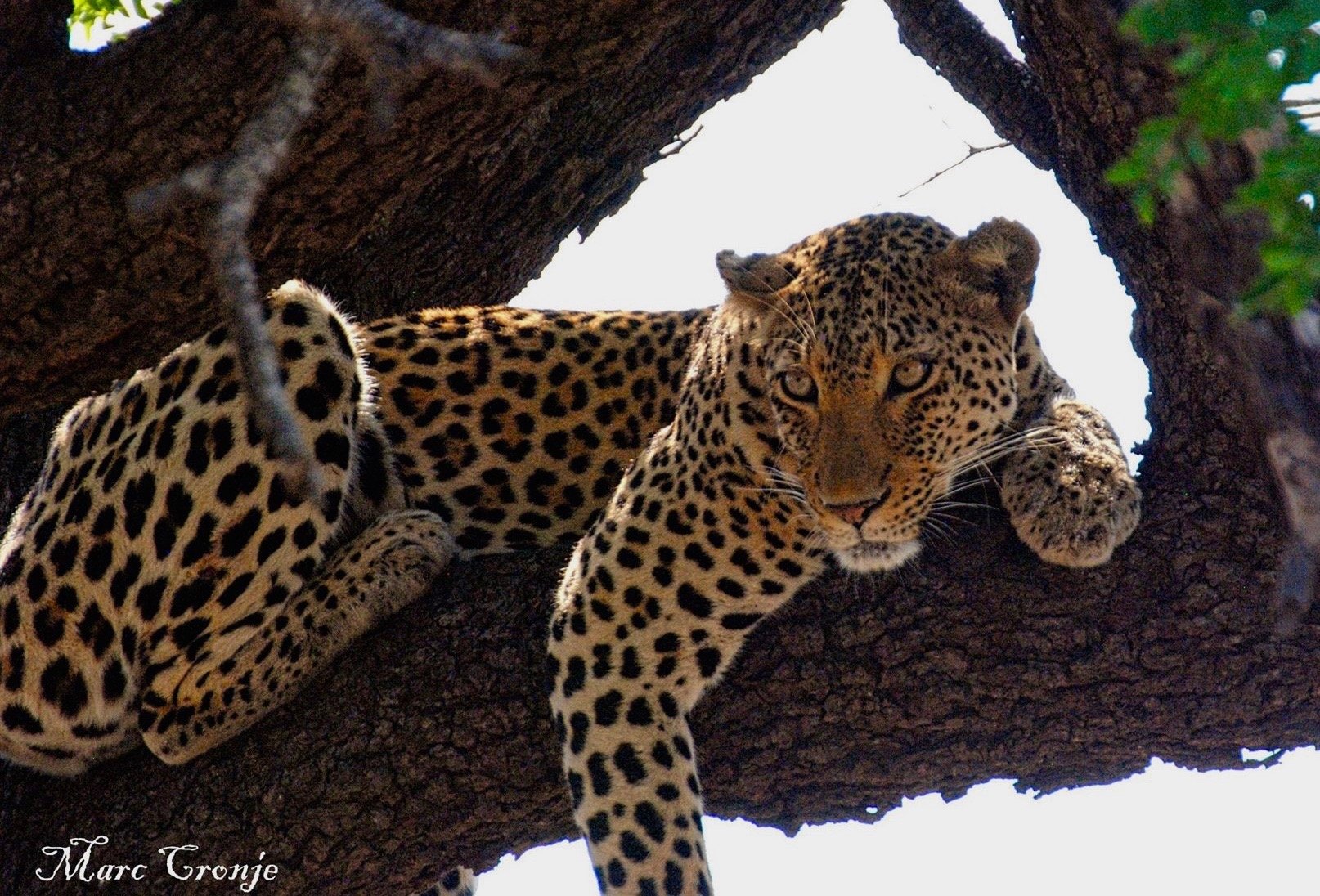
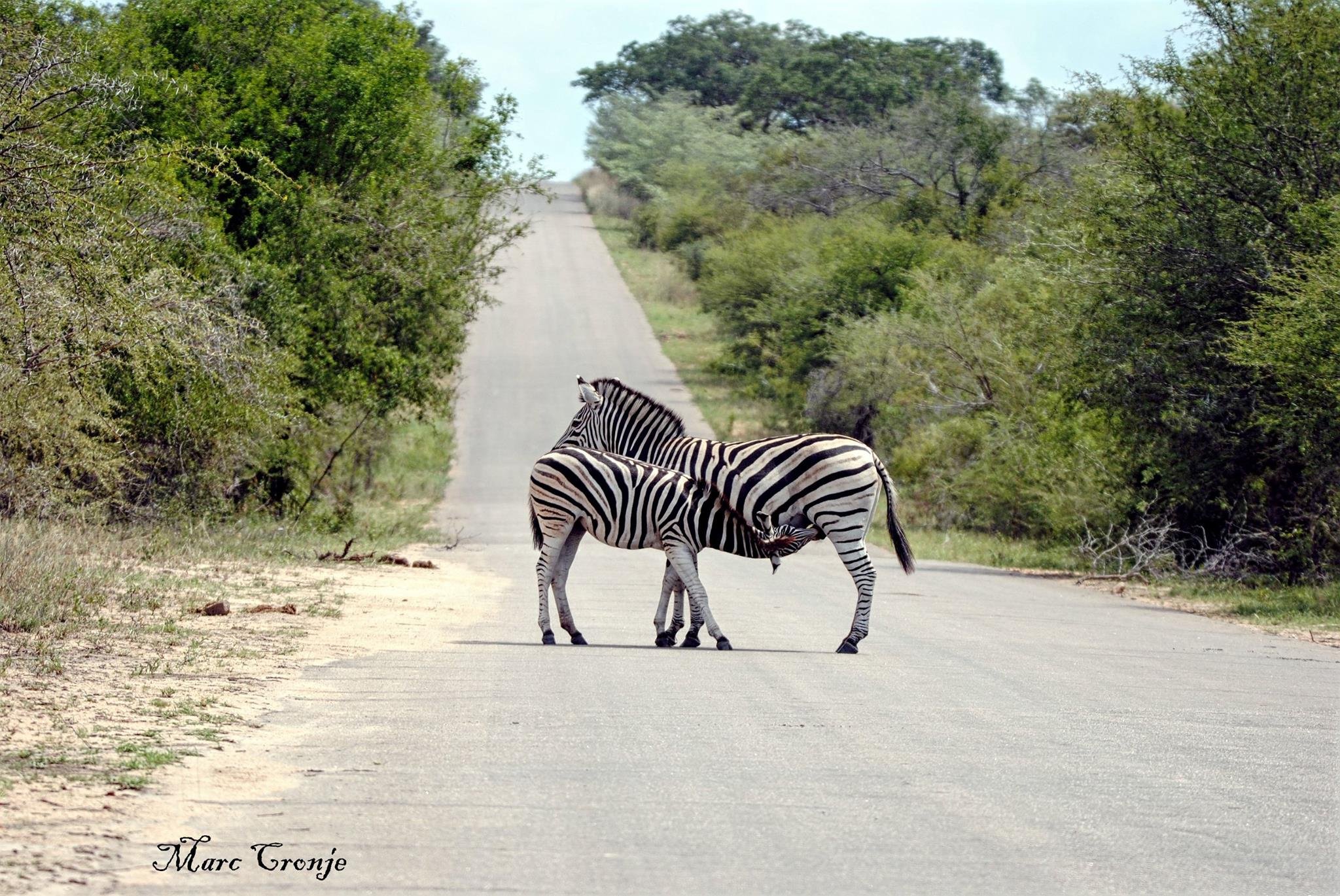

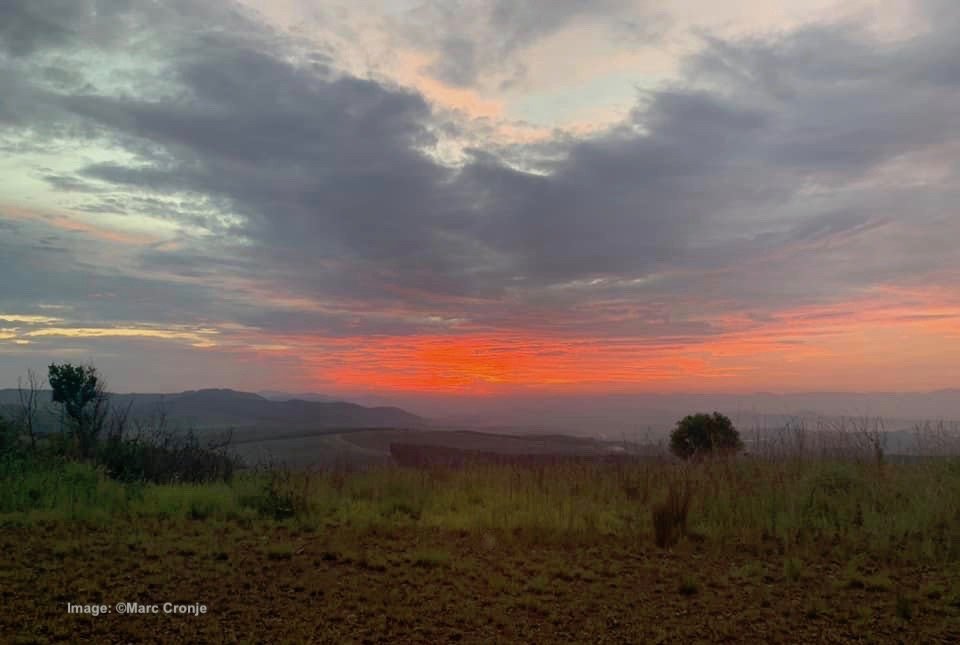
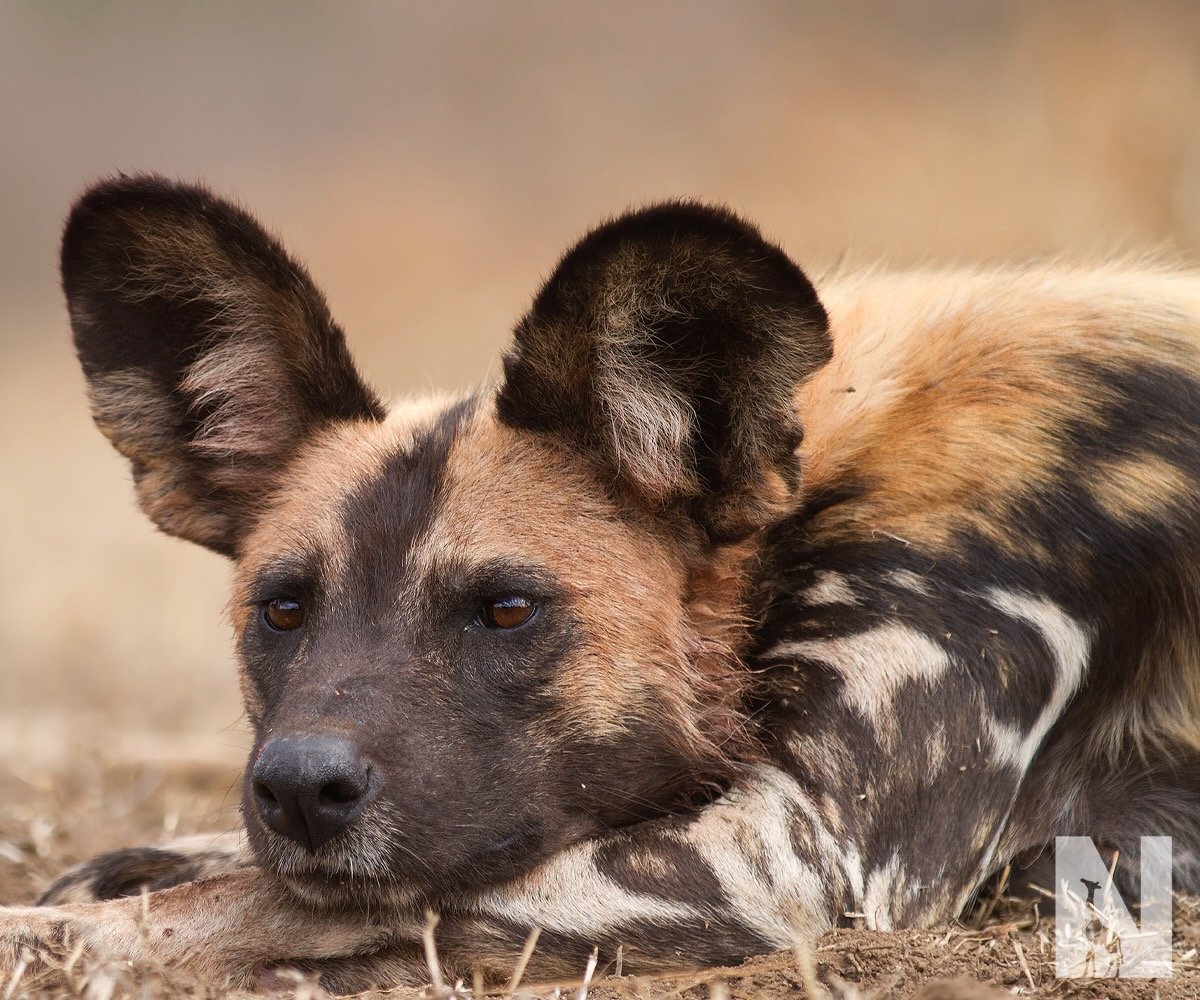
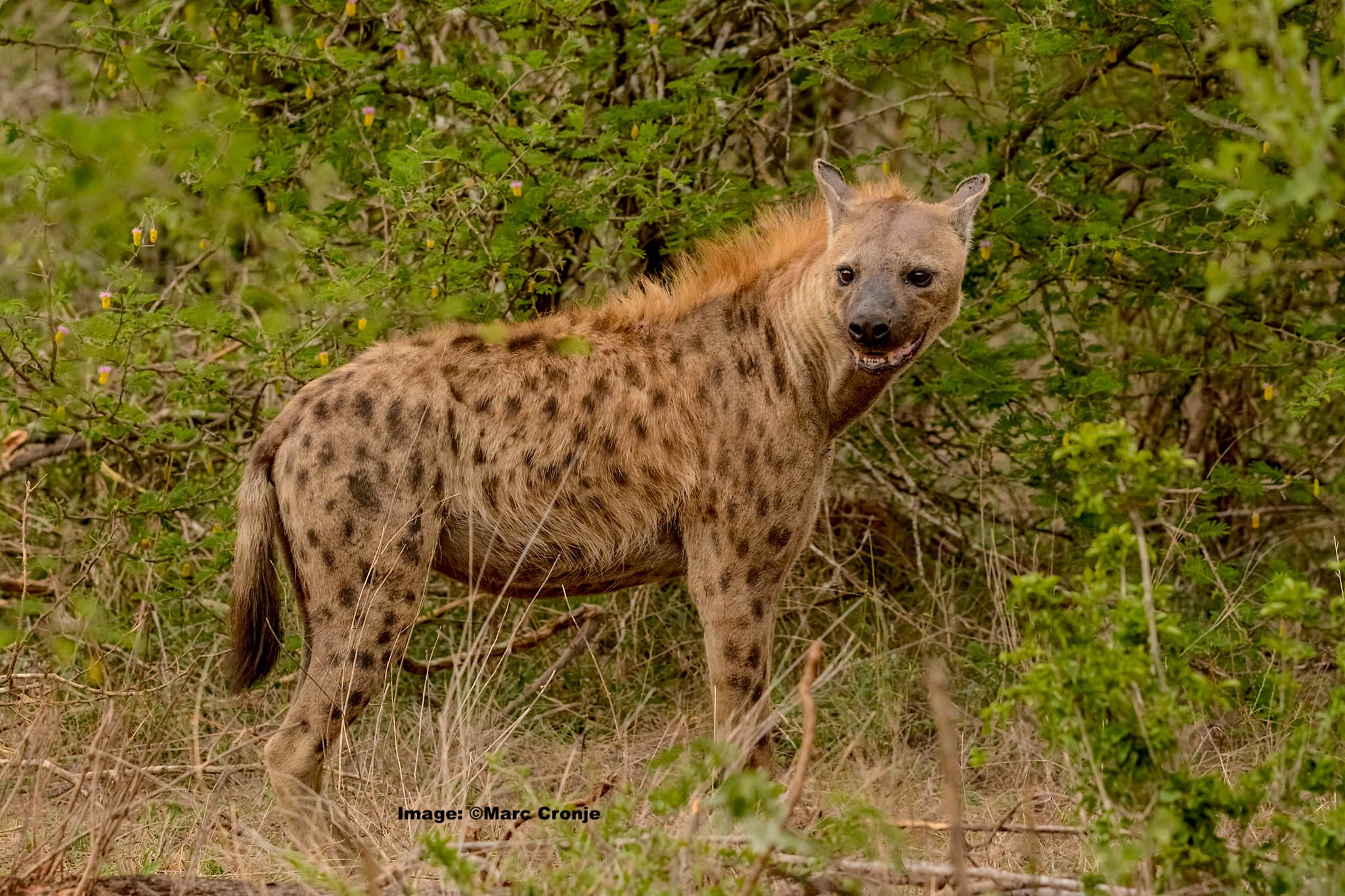
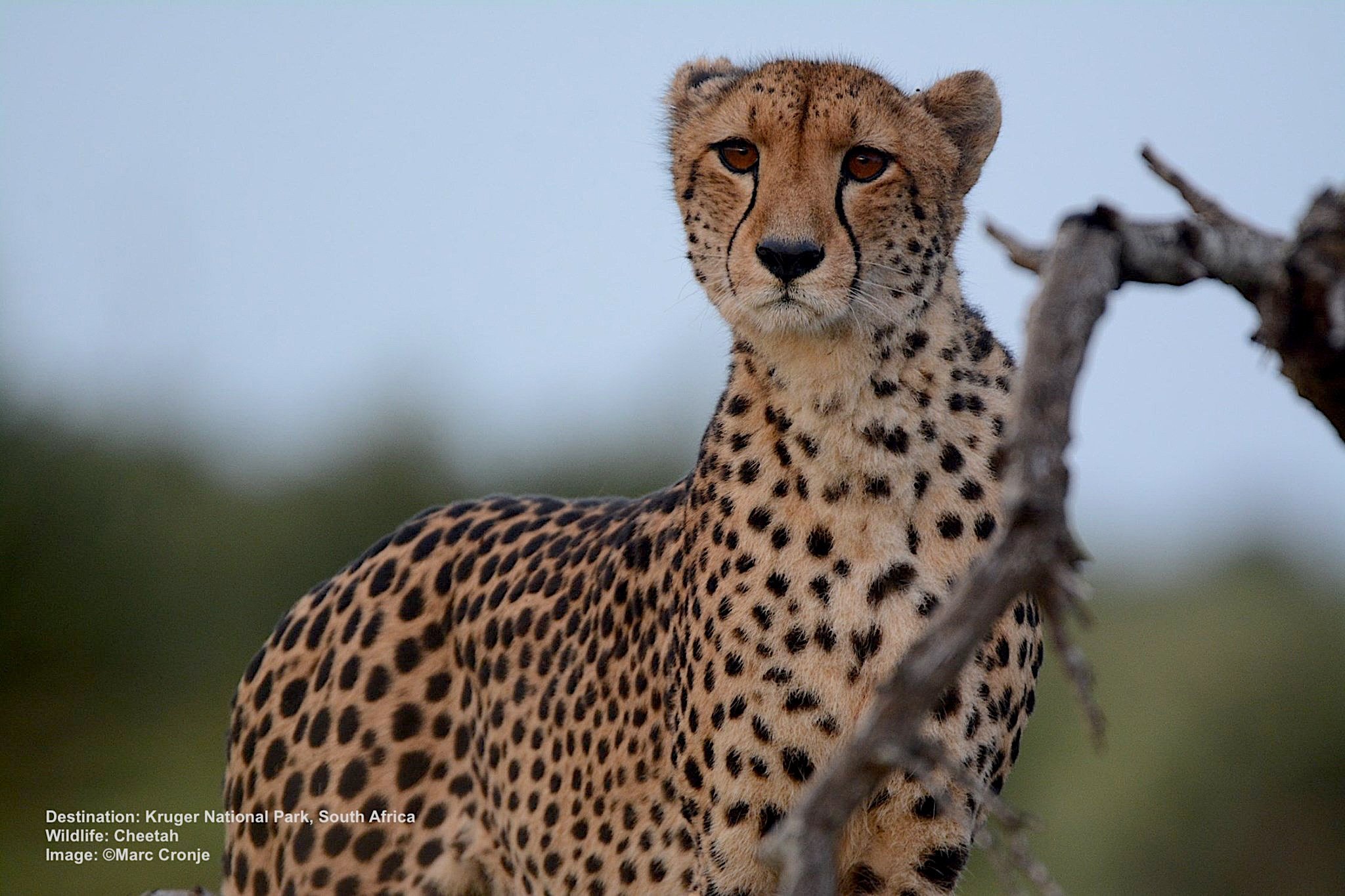

Detailed Itinerary
Your African Painted Dog Safari Itinerary
Painted Dogs are curious animals. Image ©Marc Cronje
Day 0 (August 15, 2025)
Welcome to South Africa!
We will spend our first night in South Africa at an airport hotel adjacent to OR at Tambo International Airport. Here we will relax, meet our companions, enjoy a welcome dinner, and then head to our beds early to get ready for our adventure starting in the morning.
Welcome dinner
Accommodation: City Lodge OR Tambo
adjacent to OR Tambo International Airport.
Day 1 & 2: (Aug, 16, 17)
The Kruger National Park, Berg en Dal Camp
This morning, we will take an internal flight (not included) to Kruger / Mpumalanga International Airport, where our adventure will start. Our guide will meet us at Kruger / Mpumalanga International Airport near White River, a small town on the southwestern corner of the park.
We will hop into our comfortable open safari vehicle (or “OSV” to those in the know!) and then head straight into the Kruger National Park. After entering the park's Malelane Gate, we will make our way to the beautiful Berg en Dal Camp.
Berg en Dal, meaning 'mountain and dale', is aptly named for its superb location on the bank of the Matjulu spruit and is surrounded by rocky hillsides. It is one of the new generation of camps and was opened in 1984. Great care has been taken to preserve the natural vegetation in the camp area, which comprises Malelane Mountain Bushveld (woodland), attracting a variety of grazers.
The area hosts high numbers of White Rhinoceros, Greater Kudu, Impala, Giraffe, some African Elephant, Southern Reedbuck, Klipspringer, Grey Rhebok and Common Warthog. Leopard and African Wild Dog are also regularly seen in the region.
A zebra mom and her colt cross the road at Kruger National Park Image: ©Marc Cronje
We will spend two nights in the camp in our comfortable bungalows, going on morning and afternoon game drives. The area's scenery is characterized by beautiful rocky outcrops and small hills, which make for some fantastic photographic opportunities. We will look for all sorts of interesting animals, birds, plants, and anything else that catches our eyes! We might venture north towards the famous Afsaal picnic spot or eastwards along the Crocodile River on one of Kruger’s most productive dirt roads.
As always in Kruger, it is important to explore the rest camp itself for some fascinating fauna and flora. Berg en Dal is especially suited to extra exploration. On one of the days we might try the Rhino Perimeter Trail walk that goes around the rest camp. Not only is it a beautiful, relaxing, and informative exercise, but we might also get to see something interesting! Recently, on this walk, there have been sightings of the rare White-backed Night Heron, the ferocious Honey Badger, and the sought-after Thick-billed Cuckoo, to name just a few.
The camp has a beautiful swimming pool to cool off in, as well as good restaurant facilities, a well-stocked shop and a nightly video show with some interesting local nature programmes if you are interested.
Breakfast and Dinner
Accommodation: Berg en Dal Camp
Kruger and the IdubeGame Reserve are home to a strong population of elephants Image: Courtesy of ©Idube Game Reserve
Day 3 & 4: (Aug 18, 19)
The Kruger National Park, Skukuza Rest Camp
Next we will move to Kruger’s most well-known camp. Skukuza is the park’s administrative headquarters, its largest camp, and sometimes feels like a small town compared to the other camps in Kruger. It is situated on the southern bank of the Sabie River.
The Sabie is a perennial river and one of the largest and most biologically diverse in the park. The habitat here comprises riparian zones, with large trees lining the river banks, and Sabie River thickets away from the river courses. The permanent water source here attracts large numbers of Impala, one of the main prey items of African Wild Dog and Leopard, and we will be on the lookout for these and other predators such as Lion and Spotted Hyena.
African Elephant and African Buffalo are also common in the area, usually heading down to the river as the day heats up. The area is, however, not really suited to large numbers of grazing animals, and small herds of browsers, such as Greater Kudu and Bushbuck, are more common here.
We have two nights at Skukuza, spending mornings and afternoons out in the field looking for mammals, birds, and anything else that interests us. We will traverse the southeastern section of the park, going down to Lower Sabie Camp (with its tranquil Sunset dam nearby) or even venturing further south to Crocodile Bridge Camp.
Our daily routes will depend on what we have seen so far, the general weather, and other wildlife conditions. We may visit the famous Lake Panic hide near Skukuza’s nursery, a great spot from which to see aquatic bird species and animals drinking close up. Marc, our guide, will decide where to point the nose of the safari vehicle to ensure our maximum enjoyment!
When we are not out on safari in the park it is important to look around for interesting creatures even inside the camp fence. The camp grounds are well-foliaged and there are some lofty trees along the river’s edge. Activities and facilities are diverse, as are the animals and plants found both within the camp and in the surrounding areas. The camp is a great place to spot the dove-sized Wahlberg’s Epauletted Fruit Bat and the very cute South African Thick-tailed Galago.
The camp also houses the Stevenson-Hamilton Memorial Library and Museum (James Stevenson-Hamilton was the first warden of Kruger National Park), it has some fascinating artefacts on display. You’ll learn some things about Kruger Park that you’d never imagined! There are also very engaging stories to read, like the miraculous tale of Harry Wolhuter, one of Kruger’s very first game rangers, complete with real-life props showing his escape from a Lion attack while patrolling on horseback. Note: We will NOT be patrolling on horseback.
Kruger National Park is famous for its population of Leopards. Image: ©Marc Cronje
Breakfast and Dinner
Accommodation: Skukuza Rest Camp
Day 5 & 6: (Aug 20,21)
Kruger National Park, Satara Camp
Our next destination is Satara Camp, about 90 kilometers (56 miles) north of Skukuza.
Satara itself, although fairly large, has a rustic charm. Most of the accommodation is set out in a series of circles. The nightly fires burning in front of the bungalows are a special sight. The ambiance of the camp, Kruger’s third biggest, recalls the mood of colonial Africa with red-roofed public buildings, thatched chalets, and neatly raked paths.
We will spend two nights here, again going on morning and afternoon game drives, thus maximizing our chances of seeing animals, birds, and other interesting fauna and flora. We will definitely explore one of the most famous roads in the entire park, the S100, which runs east-west from Satara towards the Lebombo mountains and Mozambique.
Many long-time visitors to Kruger swear by this road for spectacular sightings of the Big Five, many species of raptors, and other rare creatures. Will also venture to the nearby Nsemani and Sweni dams that are always worth a “stop-and-scan”. The road that runs westwards from Satara to the park’s Orpen gate has recently been a hotspot for a big pack of African Wild Dogs, and we are sure to look for them!
Welcome to Cat Camp! The sweet grasses that grow on the fertile soils formed on shale and volcanic basalt, and an abundance of excellent browsing trees, sustain the largest Impala, African Buffalo, Giraffe, Greater Kudu, Common Wildebeest, Plains Zebra, Waterbuck, and Sable Antelope populations in the Park. Satara, however, is Lion territory, as no fewer than 50 prides occupy home ranges in this area, with an average pride size of 12 lions. Within a 20-kilometer (12.4-mile) radius of Satara, 22 lion prides have been counted! Satara is rightly known as “cat camp”. Lions are inevitably followed by scavengers, and this area also contains large numbers of Spotted Hyena, Black-backed Jackal, and vultures. It is also one of the best areas in the entire Kruger to see Cheetah.
The camp itself is always worth exploring, and a walk inside the fence perimeter might give us views of Honey Badger, African Scops Owl, and Red-billed Buffalo Weaver. An optional night drive from Satara might yield Cape Porcupine, Leopard, and even the elusive Aardvark.
The camp has a beautiful reception, shop, and restaurant area, as well as a large swimming pool and a petrol station.
Breakfast and Dinner
Accommodation: Satara Camp
Plains Zebra herd at the Idube Game Reserve. Image with permission from the ©Idube Game Reserve, all rights reserved
Day 7,8 & 9 (Aug 22,23,24)
Sabi Sands Game Reserve: Idube Game Reserve
A Final Look at Kruger. After a last-morning drive and breakfast, we will wave Kruger goodbye and exit via the Paul Kruger Gate. Shortly after, we enter the adjacent Sabi Sand Game Reserve, a 65,000-hectare (160,618.50-acre) private conservancy that has no fenced boundary with Kruger National Park, allowing the game to move freely between the two.
We will make our way to Idube Game Reserve, our home for the next three nights.
Welcome to Idube. In 1983, the Marais family purchased the reserve and chose the beautiful and isolated site amongst gorgeous large rocks and overlooking a dry but occasionally running riverbed to build their camp. Idube was named after the Shangaan word for ‘zebra’. Traversing 10,000 hectares of pristine wildlife area, Idube is home to the Big Five and many other fascinating animals, large and small. It is an oasis in the wilderness with established trees and verdant lawns. All suites come complete with wi-fi, air-conditioning, a hairdryer, mosquito nets, a safe, and a private deck.
At Scotia Dam. Hippos move surprisingly fast (30 km/hr/ 19mph) and can weigh up to 1500 kg / 3300 pounds. Image: Courtesy of ©Idube Game Reserve, all rights reserved.
The Sabi-Sands Game Reserve. We will check in in time for lunch and have time to relax before our first-afternoon safari, led by an experienced local field guide and tracker. The Sabi Sand Game Reserve offers what is widely considered the best cat viewing in Africa, with regular close-up encounters with both Lion and Leopard to be anticipated. We will also look for our African Wild Dog and Cheetah in the reserve, although both are fairly nomadic within their large home ranges. Their roaming takes them out of the reserve and into the neighboring Kruger National Park and Manyaleti Game Reserves. Will we be lucky at Sabi-Sands? Sabi Sands is rightly considered the best place in the world to see the Big Five, and your three-night stay basically guarantees that we will experience them all, some of them more than once.
Experts in the (ancient) field. In addition to the wonderful animals we are likely to see here, a true highlight will be observing the local trackers practicing their craft as we track the different wildlife species; these guys are good! We have twice-daily game drives available, maximizing our chances of some truly unforgettable sightings and experiences.
We will enjoy superb wine and excellent local cuisine in the evenings after the afternoon safari, and all together, this will add up to a truly unforgettable experience. We have three nights in the reserve, giving us ample time out in the field studying, photographing and just generally enjoying our fauna and flora subjects.
On our third night, we will have a celebratory dinner with Marc, who will leave us at the airport as we head for Cape Town.
Breakfast, Lunch, and Dinner
Accommodation: Idube Game Reserve
The Endangered African Penguin is only found in South Africa. Image: ©HBH
Day 10: (Aug 25)
Morning activity and transfer to the airport (onwards to Cape Town Extension)
After our 10-day Southern Kruger and Sabi Sands safari extravaganza, your Nature Travel guide will transfer you back to the airport for your onward journey to Cape Town.
We will take an internal flight to Cape Town International Airport (not included). We will be met at the Cape Town International Airport. A representative will meet you at the arrivals hall of the airport with our names on a signboard. We will be transferred to our hotel close to the V&A Waterfront where we will spend the next three nights.
Day 11 and 12 Cape Town, *(Activities can be alternated according weather)
Day 11: (Aug 26)
Exploring Cape Peninsula
After breakfast, we will be picked up at your accommodation for our full-day Cape Peninsula Tour. We will tour the Peninsula area and spend some time in the Cape Point Nature Reserve and Boulders Beach for the Penguin Colony.
If the weather permits, we will take the cable car up Table Mountain and enjoy spectacular views from the top!
Breakfast
Accommodations: TBD (included.)
Day 12: South African Vineyard Discovery (Aug 27)
After breakfast, we will be picked up at 08h30 for your full-day Cape Winelands Tour.
After a day in the vineyards, we will head back to Cape Town, where we will enjoy a celebratory final dinner together on the continent and drink a toast to the incredible African Painted Dogs and our adventure in South Africa.
Breakfast and dinner
Accommodations: TBD (included.)
Day 13: (Aug 28)
Morning Activity and Departure – End of tour
We have the morning at leisure to explore the V&A Waterfront or visit some of the other sites in and around Cape Town.
We will be transferred to the airport for our departure flight home.
What to Expect
What to Expect on Your Safari
Will we see the elusive African Painted Dog? There is no guarantee, but we will be visiting one of the last strongholds of this Endangered species. Image: Courtesy of ©Idube Game Reserve. All rights reserved
Included
✓ Return Airport Transfers from Kruger Mpumalanga International Airport to Kruger area
✓ Return Airport Transfers from Cape Town International Airport to Portswood Hotel
✓ 1 night of shared accommodation at OR Tambo International Airport Hotel
✓ 6 nights of shared accommodation in Kruger National Park
✓ 3 nights of shared accommodation in Sabi Sand Private Game Reserve
✓ Breakfast and Dinner in Kruger National Park
✓ Breakfast, Lunch, and Dinner at Idube Game Reserve
✓ Local drinks at Idube Game Reserve
✓ All park, conservation, concession, and vehicle entry fees
✓ Full-time professional naturalist guide
✓ Open Safari Vehicle for all game drives
✓ (Extension) 3 nights shared accommodation in Cape Town (bed and breakfast) basis
✓ (Extension) Breakfast in Cape Town and Johannesburg
✓ Air-conditioned vehicle for activities in Cape Town
✓ Fuel ✓Toll Fees
Excluded
x International and Internal Flights
x Gratuity
x Laundry
x Lunch in Kruger National Park
x Lunch and Dinner in Cape Town
x All beverages including water (except at Idube Game Reserve)
x Visa Fees
x Comprehensive Travel Insurance
Is this Trip Right For Me?
Theme: African Safari with Emphasis on African Painted Dogs
Trip Duration: August 15 - 23, 2025
Trip Type: Small Group.
Max:6 guests + D:W Host + guide.
Service Level: Comfortable to Premium
Activity level: Leisurely
Best For: Adults
Age Requirements: 18+ years
COVID-19: All Guests must have proof of vaccination.
Read More about Kruger National Park here Read More about Africa Painted Dogs Here
Watching wildlife watchers can be exhausting! Thankfully, there is time for a rest. Image: ©Marc Cronje
Travel Notes
► Activity Level: Leisurely. Travel by open vehicle in Kruger and Sabi Sands, closed, air-conditioned vehicle in Cape Town. Some walking.
► Weather and Temperature Changes : August and September in South Africa (~ 40-75F)
► Health: From the CDC - Travel To South Africa Vaccination Recommendations Destination: Wildlife requests full COVID vaccine for the protection of all participants.
► Visa Requirement: State Department Washington, DC
❖ Additional Resource for Health and Visa Questions: Passport Health USA
Please Note: Destination: Wildlife is not connected in any way nor does it endorse or indemnify information on the site.
► Drinking water: Purified water is available (sold) at all lodges and will be supplied (included) in the vehicle.
Water is becoming a scarce commodity in Africa and much of the rest of the world, vast regions are experiencing desertification due to misuse and the effects of climate change. Please be aware that you will now be charged for drinking water (not included) in lodges and other public places in South Africa. Although the fee remains reasonable, it is a good reminder of how precious clean drinking water is to all life. Please bring a refillable personal container for daytime use.
► Single-Use Plastics: The policy at Destination: Wildlife is to Ban or Limit Single-Use Plastics on our Tours as possible. That includes beverage bottles, plastic bags, containers, single-use straws, etc. There will be clean drinking water available in the vehicle. Please bring your own refillable water container.
► Group Size: 6 guests, including your host from Destination: WIldlife, and a professional guide (bird specialist)
► Packing: Pack as lightly as possible in one soft-sided bag plus your carry-on. A packing list will be provided.
► Recommended Equipment: binoculars, camera, short lens, long lens, personal, reusable water bottle or canteen, insect repellant, and sunscreen.
► Travel insurance: Travel insurance is strongly recommended for all international travel. Ask us about the best policy for your needs
Travel Insurance
For all Destination: Wildlife tours, guests must have a minimum level of travel insurance coverage for medical emergencies. We highly recommend comprehensive travel protection for your tour. If you decide against Travel insurance, you must sign a waiver of release before departure. Travel insurance may cover you for cancellation due to illness, lost bags, missed flights, and other unexpected occurrences. Please see our cancellation policy
Important note: Most travel insurance does not cover preexisting conditions unless purchased within 14 days (of the initial deposit and 7 days for some carriers). A pre-existing condition can be anything from an allergy to a back problem to a heart issue. We highly recommend purchasing your travel insurance immediately after making a deposit. Additionally, if your job, business, or the condition of a family member may cause you to cancel after your deposit, ask about specific plans to help protect your investment.
Please contact us if you need assistance.
Terms and Conditions
Your deposit holds your spot. We strongly recommend Travel insurance.
Due to the nature of our tours, no refunds are available once a tour has started or for any package, accommodation, meals, or other services included. We understand that sometimes, even the most eagerly anticipated plans may need to be canceled. We strongly recommend that every traveler purchase travel insurance. Cancellation Policy.
Cancellation: More than 120 Days
Forfeiture of 10% of trip fees, including extensions, plus any specified donations to the sponsor, and any non-refundable train/airfare. *
Cancellation 120 to 90 Days
Forfeiture of 50% of trip fees, including extensions, plus any specified donations to the sponsor, and any non-refundable train/airfare.*
Cancellation 90 or Less
Forfeiture of 100% of trip fees, including extensions, plus any specified donations to the sponsor, and any non-refundable train/airfare.*
*Where another guest fills the space, a portion of your fees may be eligible for an additional partial refund, subject to Destination: Wildlife's sole and exclusive discretion.
Making a Difference
How Your Trip Makes A Difference
At Scotia Dam. Hippos move surprisingly fast (30 km/hr/ 19mph) and can weigh up to 1500 kg / 3300 pounds. Image: Courtesy of ©Idube Game Reserve, all rights reserved. . Image courtesy of ©Idube Game Reserve. All rights reserved
As with all of the Destination: Wildlife tours, this one is an Unforgettable Journey that Does Good at the destination, and at home. In Kruger National Park, we will be staying in lodges that are run by Sans Park, dedicated to protecting biodiversity and creating socio-economic change. Outside of Kruger, we will enjoy a private reserve that abuts Kruger and expands the protected habitat used freely by wildlife. Our visit makes the protection of wildlife, birds, and the habitat they need economically possible. And protecting natural habitats helps to mitigate the causes of climate change. Our responsible travel helps the earth - and it’s fun!
How Your Trip Helps the World is Up to You
Destination: Wildlife will donate 5% of your (double occupancy) tour cost (about $592.00 per ticket) in your name to one of three US-based conservation-missioned 501c3 organizations - you choose.
The Wolf Conservation Center:
Our mission is to advance the survival of wolves by inspiring a global community through education, advocacy, research, and recovery. We are driven by our values of respect, community, and passion.
Respect - We respect wolves, their complex ecological role, the landscapes they shape, the people who care about them, and the people who live among them.
Community - We are inspired by the pack. We bring people together, we nurture, we educate, we aid, we protect, we organize, and we defend. We are always stronger together.
Passion - We have a passion for wolves, for the landscapes we share, and for the work of protecting them. Our passion drives us to learn, see the big picture, and be diligent and tenacious in the long-term work of saving wolves.
The Great Swamp Conservancy:
Mission Statement: “To foster environmental, cultural, and natural history education, promote outdoor recreation and preserve biological diversity, and conserve and manage natural resources in the Oneida Lake and Lake Ontario watersheds.”
The primary focus area of the Great Swamp Conservancy (GSC) is on the southeastern shore of Oneida Lake in the towns of Lenox and Sullivan. This area is home to what the Iroquois called the Great Swamp, a remnant of Lake Iroquois. The Great Swamp was drained for agriculture from the late 1800s to the mid-1900s, creating rich black muck soils. The GSC’s driving force has been to return a portion of these wetlands to their original state through partnerships with landowners, and local, state, and federal governmental agencies.
The healthy, restored habitats of The Great Swamp Conservancy, designated an IBA (Important Bird Area) by Audubon, are again home to a plethora of resident and migratory birds. Depending on the season, you might see breeding osprey and great blue herons (the rookery is fascinating!) or great horned owls, wild turkeys, bobwhite quail, bluebirds (I saw my first one here), cedar waxwings, belted kingfishers and other wetland birds, Cooper's hawks, and numerous woodpecker and songbird species. You might also find beavers, muskrats, fishers, coyotes, white-tailed deer, frogs, and other amphibians, garter snakes, and turtles. And fish! Including bass, sunfish, bluegills and bullheads
The Grassland Bird Trust:
Vision Statement: We envision a resilient landscape of conserved grasslands across North America teeming with healthy populations of native grassland birds.
Short-eared Owls, Northern Harriers, Upland Sandpipers, Bobolinks, Eastern Meadowlarks, and other iconic grassland bird species are once again a common sight across their historic breeding and wintering grounds. Conserved grasslands support an abundance of birds, pollinators, and other wildlife, and local communities benefit from grassland conservation and wildlife-watching ecotourism. Grassland Bird Trust (GBT) partners with landowners, government agencies and other organizations and stakeholders to ensure the recovery of endangered and threatened grassland bird species while expanding economic benefits for local communities.”
The Washington County grasslands are designated IBA (Important Bird Area)
Reviews
Reviews for Destination: Wildlife
Read more reviews for Destination: Wildlife’s Unforgettable Journeys that Do Good!
It was a unique experience and at the top of any trip I've ever taken. And thank you for always looking out for me.
Kate, New York state
Birding in Costa Rica
10, it was an amazing trip (Please rate from 1- worst to 10 – best)
Liz and Alan, New York state:
Birding Costa Rica and Private Sail Cruise 2021
We are in awe of the care that you took to make our trip successful. The attention to detail and your ready availability when things didn’t go as planned. Your excitement as our trip progressed and the supervision to the very end to make sure everything turned out alright. Thank you for all that you do. Liz & Alan
Noreen, New York State
Exploring Women’s Winter Wolf Trek
The trip was fabulous and couldn't have been much better. My one suggestion is around the Zoom call. I was impressed that you did a Zoom call rather than just sending a gear list - it is an example of how much personal attention you devoted to us.
Reviews for your Guide: Nature Travel Namibia
Namibia Safari
Janeen, Hobe Sound, Florida USA, December 2021
Over the last nine years I have traveled with Nature Travel Namibia and Nature Travel Africa four times. My recent journey to Namibia, again, exceeded my expectations.
What a Great Trip! 380 Bird species, and 50 species of Mammal
Mike, Galway, IRE,
Birding in Namibia, May 2021
This was my first trip to Africa let alone Namibia. My main focus for the trip was to see as many bird species in Namibia as possible. After researching for a good guide that I thought would be a good fit, I chose Nature Travel Namibia (NTN) mainly due to my talks with owner Nick Buys. His attentiveness and quick thorough responses to my many questions made the decision easy.
Gillian, Cape Town, South Africa.
Birding in Namibia 29 April – 10 May 2021
Birding friends recommended Namibia as a great birding destination… Marc Cronje was my guide and he looked after me wonderfully, from meeting me at the airport in Windhoek and travelling onwards for 12 days. We drove to Rundu in the Caprivi Strip, then through Mahangu, across the border to the Okavango Panhandle in Botswana (including fabulous birding boat trip), back into Namibia for a further couple of days at wonderful Mahangu National Park (and yet another great boat trip), then 2-3 days in Etosha National Park, and then a day each at the Brandberg in Damaraland, the Erongo Mountains, Swakopmund & Walvis Bay and then back to Windhoek. Namibia is fabulous with great scenery, people, game and, most importantly for me, birds.
Marc was an excellent guide: very knowledgeable and enthusiastic about all birds, wildlife and photography. He knew exactly which spots to go to find all the various bird species, allowing me to see almost all the targets we were looking for. I saw 270 different bird species over the trip (including many many “lifers”) and over 30 other animal species, with plenty of time to get good observations and photos. He was a careful driver and liaised very well with lodge staff, park staff and border officials. In addition, he was really great company and also very patient and helpful with a relative novice both as regards birding and photography.
Come play with us in Kruger National Park and learn about the wonderful, Endangered, African Painted Dog. Tour limed to six guests. Image: Marc Cronje



